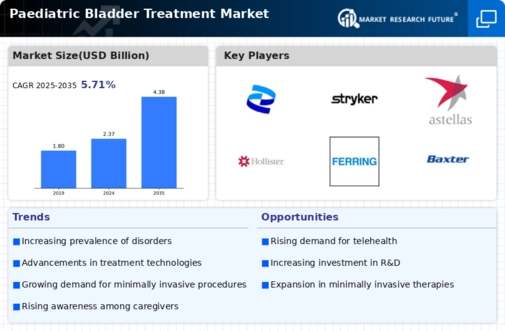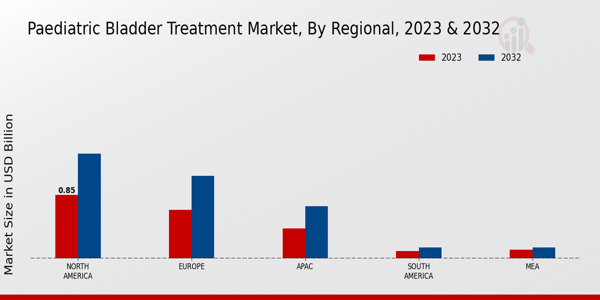Market Growth Projections
The Global Paediatric Bladder Treatment Market Industry is on a growth trajectory, with projections indicating a substantial increase in market size over the next decade. The market is expected to reach 2.37 USD Billion in 2024 and is forecasted to grow to approximately 4.38 USD Billion by 2035. This growth is underpinned by a compound annual growth rate (CAGR) of 5.73% from 2025 to 2035, reflecting the increasing demand for effective treatment solutions and the ongoing advancements in medical technology. The market's expansion is indicative of a broader recognition of the importance of addressing bladder health in children, which is likely to drive further investment and innovation.
Rising Healthcare Expenditure
The increase in healthcare expenditure globally is another significant driver of the Global Paediatric Bladder Treatment Market Industry. As countries allocate more resources to healthcare, there is a corresponding rise in the availability of advanced treatment options for children suffering from bladder disorders. This trend is particularly evident in developed nations, where healthcare budgets are expanding to include specialized pediatric care. The focus on improving child health outcomes is likely to lead to increased spending on bladder treatments, thereby propelling market growth. With the market projected to reach 2.37 USD Billion in 2024, this trend is expected to continue as healthcare investments rise.
Growing Awareness and Education
There is a notable increase in awareness regarding paediatric bladder health, which is positively influencing the Global Paediatric Bladder Treatment Market Industry. Educational campaigns aimed at parents and healthcare professionals are helping to destigmatize bladder disorders and encourage early diagnosis and treatment. Organizations dedicated to child health are actively promoting information on bladder health, leading to more children receiving timely interventions. This heightened awareness is expected to drive market growth, as families become more proactive in seeking treatment options. Consequently, the market is projected to expand significantly, reaching an estimated 4.38 USD Billion by 2035.
Government Initiatives and Funding
Government initiatives aimed at improving child health are playing a crucial role in the Global Paediatric Bladder Treatment Market Industry. Various health departments are allocating funds to research and develop new treatment modalities for bladder disorders in children. For example, public health campaigns and funding for pediatric urology research are becoming more common, which helps to enhance treatment accessibility and affordability. These initiatives not only support healthcare providers in delivering better services but also encourage innovation within the industry. As a result, the market is likely to benefit from increased investment and support, fostering growth in the coming years.
Advancements in Treatment Technologies
Technological innovations in the field of paediatric bladder treatment are transforming the Global Paediatric Bladder Treatment Market Industry. New minimally invasive surgical techniques and advanced pharmacological therapies are being developed, enhancing treatment efficacy and reducing recovery times. For instance, the introduction of biofeedback therapy and neuromodulation techniques has shown promising results in managing bladder dysfunction in children. These advancements not only improve patient outcomes but also increase the overall market appeal, as healthcare providers seek to adopt the latest technologies to offer better care. As a result, the market is anticipated to grow at a CAGR of 5.73% from 2025 to 2035.
Increasing Prevalence of Bladder Disorders
The rising incidence of bladder disorders among children is a primary driver of the Global Paediatric Bladder Treatment Market Industry. Conditions such as urinary incontinence and bladder dysfunction are becoming more prevalent, prompting a greater demand for effective treatment options. According to recent health statistics, approximately 10 to 20 percent of children experience some form of bladder dysfunction, which necessitates medical intervention. This growing patient population is expected to contribute significantly to the market, with projections indicating that the market will reach 2.37 USD Billion in 2024 and expand further as awareness and diagnosis improve.













